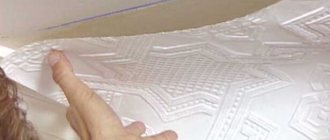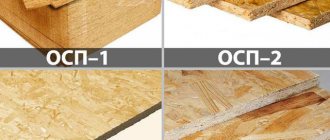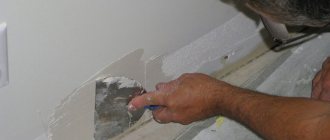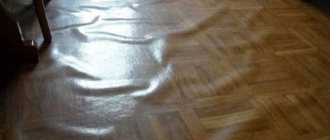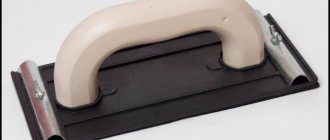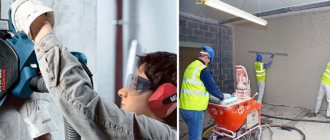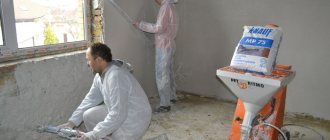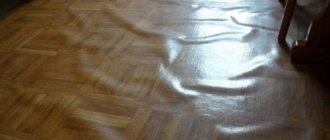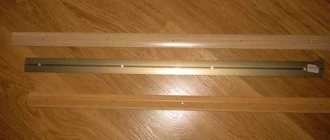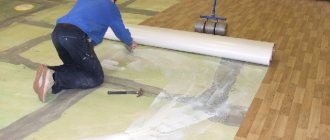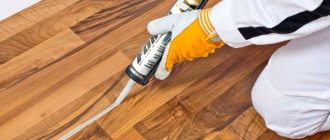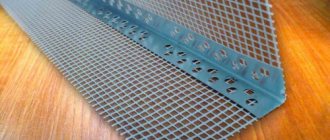How to take measurements for laying carpet on linoleum
Most people advise laying it in one piece to avoid joining two or more parts. There is no room for mistakes in this process; you need to take the measurements correctly. On paper or on the computer, make a diagram of your room with the dimensions of the room. Be sure to consider the length and width of each corner, niche, and ledge. Be sure to add 10 centimeters to the data obtained for margin. It’s better to cut it off later than to “finish off” the coating with small pieces. But you shouldn’t be fanatical about your stock, so as not to buy too much.
Taking room measurements
What to focus on:
- Wall transition angles. Uneven corners will add problems in taking measurements;
- Room area. When the room is very large, you will have to work hard to find the right piece of carpet. Find out in advance whether the material of the required dimensions is available, or order it;
- All sorts of non-standard moves in the layout should be taken into account. This is also necessary for accurately ordering consumables;
How to prepare the surface for laying carpet on linoleum
Preparing the old coating as a base is an important stage of the process; the result directly depends on it. Swollen defects in linoleum will be repeated on the new coating. Therefore, all areas of swelling must be brought back to normal.
Also make sure that the old linoleum is firmly attached to the sub-base. Patches need to be applied to the cut and burnt parts of the coating. If the joints between pieces of covering or joints with walls have peeled off, they need to be glued. With certain installation methods, it is necessary to clean the material from dust and grease. To do this, use a brush, a vacuum cleaner, and then special products. In the photo you can see how to solve the problem with longitudinal cuts.
One more point - the base must be dry. If you do not adhere to this rule, the quality of adhesion will be poor and will affect the life of the floor.
Fixing flaws is easy
How to lay carpet on linoleum with backing
The material used for such bases is felt, rubber, polyurethane foam or other synthetic material. The properties of the linings are rigidity and the ability to quickly restore the structure after deformation.
Felt backing for carpet
If the linoleum is poorly connected to the rough base, this deficiency will have to be addressed. Experts use blocks of wood chips or plywood as a subfloor.
How to lay carpet on linoleum without backing
In the case when the linoleum is firmly connected to the rough area, there is no need to use an additional substrate, and this can save money. Then all work is carried out specifically with linoleum; it must be cleaned and degreased. Removing fat elements is necessary for a good “fight”.
It is recommended to use special products to degrease the surface. As a last resort, you can dilute dishwashing detergent with water and cover the material with this solution, and then rinse with clean water and leave to dry. But you shouldn’t use gasoline; you’ll have to ventilate it for a long time, and it’s unknown how it will behave when in contact with floor materials.
The carpet should be spread across the width of the room and left for at least a day so that it gets used to the temperature and adapts. At the next stage, we cut off the excess parts, after which we move on to attaching the carpet. Skirting boards are used to securely fix the material.
How to prepare the base before starting work?
Before you begin laying the flooring, you should carefully prepare the base.
If the “base” for the material is concrete, you need to fill in all the unevenness, thoroughly clean and prime the surface. Laying carpet on a concrete floor without treating it with a primer is fraught with the constant “influx” of dust from under the covering - you will have to stand guard almost around the clock with a vacuum cleaner.
As for wooden floors, they can be “treated” in two ways:
- Cover the surface with chipboard sheets, fill the joints, and treat everything with a primer.
- remove protruding parts (nail heads, screws), scrape the surface, prime and fill with self-leveling mixture.
Article on the topic: How to level a floor with plywood: analysis of the device of 3 different options
To prevent the carpet from deteriorating and wearing out, it is advisable to lay a high-quality backing underneath it. It has been proven that it can extend the life of carpet by at least one and a half times. The underlayment gives the surface elasticity and strength, with it the floor will be even warmer and the sound insulation will be even better. This “bonus layer” will help create the effect of a dense and thick carpet, even if the covering itself is thin. The underlay, like carpet, should be purchased with a reserve.
The underlay provides the carpet with additional strength and elasticity, and also significantly extends its service life - by one and a half to two times
Article on the topic: Carpet underlay - a whim or a necessity?
How to lay linoleum on linoleum
Before laying linoleum on linoleum, you need to understand that the coating used is:
- homogeneous - using one layer;
- heterogeneous, which includes from 2 layers of different constituent materials.
The latter type of linoleum is most often laid on a concrete base, since numerous layers provide a high-quality substrate when laying the coating. A homogeneous material will be useful when laying a second layer on top of the existing one, which will become a good lining surface when laying the top covering.
Laying a new layer on the first one is not fundamentally different from the usual installation of linoleum
It is important to clean and dry the surface so that the dirt of the old coating does not make itself felt by emitting an unpleasant odor.
How to lay linoleum on linoleum with your own hands
Before laying a new coating on top of the old one, clear the room of furniture so that the linoleum is evenly distributed over the entire area. The installation method remains the same as for a concrete base.
What to glue
To fix the top layer to the first, there are several methods:
- using double-sided tape, only taking into account that when the temperature changes, waves may appear;
- using regular PVA-based linoleum glue, it is rolled out with a roller or coated with a brush, but you need to remember the difficulty of dismantling the glued layer;
- using fixing compounds that first cover the surface, allow to dry, and then lay and press. Such mixtures will not allow the new coating to move, but when dismantled, they can be easily removed.
Features of the work - stages
When laying linoleum, it is important to carefully consider all the installation nuances and follow the following order:
Take measurements of the room, adding 5–10 cm on each side, order the required linoleum patterns. The increased size is taken to cover possible defects in the building: uneven corners, differences between visible identical walls. Clean and wash the old coating, then let it dry completely. Then inspect for unevenness using the water level rule. This tool must show in all angles and planes that the level corresponds to the horizon; if not, then such a defect requires mandatory correction
Leveling is carried out using substrates of various thicknesses. During inspection and leveling, attention is paid to the presence of cracks and holes in the old coating, which are repaired. If necessary, some areas are filled with screed, especially if the base under the old layer is destroyed
Small pieces of mold are removed, the area around it is cleaned and the entire surface is leveled using the rule.
- If the change in linear dimensions entails an elongation of the coating to such an extent that it rests against one or more walls, then the material is cut again and left for another one or two days.
- The joints for shrinkage are placed on top of each other. The joint cut is made simultaneously in two parts in one movement, having previously placed a piece of plywood or cardboard under the line to be cut.
- Now, having chosen the method of planting with glue or a fixing compound, smear the back surface with the mixture and fix the coating in the required position.
How to seal joints
One of the most common methods of joining linoleum is to evenly trim both sides and gluing the joining edges to the base, in our case to the old coating. This method does not require additional tools and materials. But other methods are used in construction:
- welding with polyethylene;
- hot welding;
- cold welding type A;
- cold welding Tina C.
Conventional welding involves gluing tightly trimmed edges of linoleum to polyethylene tape, which is previously placed under the seam and coated with PVA glue. Then use an iron to heat it up.
When hot welding, a special cord and a hair dryer are used. The gap between the edges is left to the size of the cord, using a special device and a hair dryer, the required surfaces are joined. Cold welding of types A and C involves filling the gap between the edges with a special liquid adhesive mixture, which hardens over time. The only difference is the size of the gap.
Having studied the above information, the consumer will independently determine the possibility and procedure for laying linoleum on top of the old covering, which will allow the floor covering to be laid correctly.
How to choose carpet for an apartment, depending on its purpose
Taking into account the performance characteristics, you need to select a certain type of carpet for each room in the apartment. You need to be very careful when choosing flooring for a children's room. Main characteristics of the covering for a child’s room:
- the pile should be soft, but at the same time durable - such a cover will reduce injuries during games;
- good thermal conductivity - this will prevent hypothermia;
- hypoallergenic - this requirement is very difficult to fulfill, because the child may be allergic to both artificial and natural materials;
- ease of cleaning - cleaning should be done without the use of chemicals;
- the drawing must have an aesthetically attractive appearance.
For bedrooms, it is recommended to purchase dense types of coating that have good resistance to ultraviolet radiation. A third of your life is spent in the bedroom (during sleep), and a calm color scheme will improve the quality of sleep/rest.
For the hallway, it is recommended to purchase short-pile carpet with a base made of felt or rubberized material. Such requirements are due to the increased traffic and pollution that are typical for this room.
When decorating a living room, special attention should be paid to the choice of flooring, because
This is where household members spend the most time. The carpet for this room should have excellent wear resistance, durability, and also be consistent in design with the overall style of the interior.
When choosing a floor covering, you should focus not only on the recommendations of experts, but also take into account your own preferences.
Which is better?
Today, manufacturers produce many types of carpet, so before purchasing it you need to pay attention to some details. Carpet can be made from different materials using different methods
In addition, carpet products are dyed in different ways. The pile itself can have different heights and even shapes
Carpet can be made from different materials using different methods. In addition, carpet products are dyed in different ways. The pile itself can have different heights and even shapes.
The materials used to make carpet can be of natural, artificial or mixed origin.
Cotton, linen, wool and jute can be used as natural fibers. Man-made options include acrylic, nylon, olefin, and latex used as lining material. Blended fiber carpet contains both synthetic and natural threads.
The type of pile is another indicator that you should pay attention to:
- The Saxony type is considered to be of the highest quality, produced using a special technology due to which the surface has a grainy appearance.
- Another inexpensive and unpretentious type that is recognized by consumers and has earned their trust is Vkroll. In the manufacture of this type, multi-colored threads are used, and the coating itself consists of several levels. Externally, this carpet looks very attractive.
- Boucle looks no less attractive. In addition to the fact that this type is quite durable, it also has an original shape, made using a method that uses special knitting knots.
- In the production of such a type as Frieze, twisted curly thread is used.
- Based on the data obtained, when choosing carpet you need to focus on the features of the room in which it will be laid.
- For a bedroom, the best option would be a high-pile carpet, but for a living room, the pile length should be shorter, so a short-pile tufted carpet would be the best choice.
- For a hallway, a good solution would be to purchase a needle-punched covering with water-repellent properties.
- For the bathroom, wear-resistant flocked carpet is suitable, which contains nylon threads, which give this coating anti-slip properties.
How to lay linoleum on old parquet
The sequence of actions when laying linoleum depends only on the condition of the old floor covering. Depending on its condition, different methods are used to secure the material to the base, so first you need to carefully inspect all the dies. If the covering is in good condition, you can lay it directly on it. In other cases, sheets of plywood are needed. People who do not know how to properly lay linoleum on old parquet make several mistakes:
- do not use a substrate;
- they forget to eliminate all rotten dies;
- choose a simpler but ineffective installation method.
Each element of the old coating with cracks and fungus must be removed.
In order for the coating to last longer, you need to choose the right option for securing the material.
Laying method on a flat but stepped parquet
Since the tiles of stepped parquet are less than 10 cm wide, a backing must be laid under the linoleum. Such material should not be thicker than the floor covering. In small rooms, the material is not even secured with glue, but is only pressed with baseboards. With this method, it should not “slide” to the side. If the surface is large, you should first attach the underlay to the glue, and then glue the floor covering to it.
A crease appears on poorly secured linoleum
Such work is carried out only after leveling, sanding and priming the parquet. As a result, the surface should be as smooth as if sheets of cardboard were laid.
Gluing the substrate and linoleum occurs almost the same way. First, glue is applied to the base over an area of no more than 2 meters. Then the material is rolled out and the glued area from the wall is ironed. This is necessary to get rid of bubbles.
If a single piece of linoleum is spread over the entire room, it must be smoothed from one of the walls. When you need to secure 2 sheets, perform a few simple steps to hide the joint:
- lay the sheets so that there is no gap between them;
- after this you need to glue the material with transparent tape along the entire length of the joint;
- then carefully cut the tape in the middle and pour in a small amount of linoleum glue;
- at the last stage all that remains is to smooth out the joint and wait a few minutes.
When the tape is peeled off, the joint will become invisible. For a better idea of how the work happens, it’s worth watching a video on the topic.
Preparing parquet for laying linoleum
Option for laying linoleum on worn parquet
If the parquet is worn out and cannot be sanded smooth over the entire area, use sheets of plywood. They are necessary
After preparing the necessary materials and checking the parquet for mold, you need to perform the work in several stages:
- Secure sheets of plywood or fiberboard one by one with self-tapping screws directly onto the old parquet boards. They need to be laid from the far end of the room, moving towards the opposite wall.
- The gaps that form between the sheets must be filled with sealant. This is necessary to protect the old coating from moisture that may penetrate from above.
After sealing the plywood joints, a backing is laid on the material
- At the next stage, the linoleum is laid without glue so that it stretches.
- At the joints near the walls, excess material should be cut off so that there is a gap of about 1 cm, which will then be covered with a plinth.
- To glue linoleum, you need to roll it up near the wall with the window. When applying glue to its inner surface, you should carefully unwind the material and smooth out any irregularities.
- After this, you need to leave the material for a day and only then fix the plinth.
To prevent signs of wear from appearing on the material, the coating should not be exposed to heavy loads during the first week.
Laying linoleum on damaged parquet
Restoring parquet is not always advisable. However, even with serious damage, laying linoleum will hide all the imperfections. The procedure is quite simple:
- Damaged planks are dismantled using a hammer and chisel.
- The subfloor is cleaned and treated with waterproofing, and a sheathing is created.
- Lay sheets of plywood or fiberboard on the floor, fixing them with self-tapping screws to the old ceiling. All cracks are treated with sealant.
- Spread the linoleum, cutting the edges so that there is a gap of no more than 1 cm between them and the wall.
- Linoleum is placed on the base using glue. The composition is applied from one edge, gradually moving to the opposite side. The material must be smoothed, removing any irregularities.
Installation is complete, but the material is not yet secured with skirting boards
How can I glue carpet to linoleum?
Despite the fact that experts do not recommend gluing carpet onto linoleum with adhesives, this technology is still acceptable. It is based on the use of glue without aggressive solvents. Such compounds are used to glue the linoleum itself to the floor, so they are safe and do not react chemically. The most popular types of glue are:
- PVA glue is water-dispersible. It is safe for linoleum. However, the glue breaks down in a humid room. The lack of elasticity after hardening affects the service life. Over time, the carpet will begin to peel off from the linoleum. Acrylic adhesives have similar properties, but they have better adhesion to materials. PVA glue is resistant to moisture and frequent mechanical impact
- Velcro is a unique adhesive composition that allows you to glue carpet over linoleum. If necessary, it can be torn off and re-glued. The Velcro hardens after 25 minutes, after which it “eternally” retains its properties. Velcro KIILTO GRIP is popular
- Two-component polyurethane types have increased strength and consist of a base and a hardener. The components are mixed immediately before use. Two-component compositions consist of glue and hardener
Of the three options, it is optimal to choose Velcro. Water-dispersed compositions are short-lived. Two-component adhesive is optimally used when the carpet needs to be glued to the wall. It is toxic and can react with some types of linoleum.
How to lay carpet on linoleum using glue
If the adhesive installation method is chosen, the carpet is spread over a cleanly washed floor, but is not adjusted by precise trimming. They leave a small reserve. The canvas is approximately visually divided into two equal pieces, after which one part is wrapped. Apply glue over the floor surface with a spatula, gradually push the carpet over it, and smooth it with a roller. When one piece is glued, wrap the second part. Do the same actions.
The wrapped piece of carpet is gradually pushed onto the glued area of the floor.
When the carpet is glued over the entire floor area, adjustments are made at the walls. Excess pieces are cut off, the edges are pressed with plinths. Do not walk on the floor until the glue hardens.
How to lay carpet on linoleum using tape
For gluing, double-sided tape with a width of 60-150 mm is used. The floor must be free of grease and have a perfectly flat surface. Strips of tape are glued around the perimeter of the room near the walls. A mesh with a square size of 500x500 mm is glued over the entire floor. The top paper layer is not removed from the tape.
The protective paper is removed from the tape gradually as the carpet is rolled out.
The carpet is rolled out on the floor and adjusted, leaving reserves on all sides. After two days of resting, half the piece is wrapped. The protective paper is removed from each strip of tape in turn, the carpet is pulled up and smoothed with a roller. Do the same with the second piece. Finally, precise trimming is done near the walls and fixed with plinths.
How to secure with thresholds and skirting boards
The easiest way is to lay carpet on linoleum without tape or adhesives. After resting for two days, the canvas is simply rolled out using the method of a regular carpet. The walls are adjusted to size, leaving an overlap of 8 cm, and fixed with plinths. On door thresholds, the edge is covered with an aluminum strip - a threshold.
With a glueless installation method, pressing the canvas is carried out only with baseboards
The disadvantage of this method is the risk of swelling over time. Do not use a vacuum cleaner for cleaning. It is unacceptable to move furniture on wheels.
No. 2. Type of material: natural or artificial?
Carpet pile can be made from natural or artificial materials. The choice depends on where you plan to use the coating.
The following materials can be used to make natural carpet:
- animal fiber (wool, silk);
- fiber of plant origin (cotton, flax, jute, sisal, etc.).
The most popular raw materials for the production of natural carpet at the moment are:
- wool. Most of all natural carpet is made from it. In addition to naturalness, such products boast excellent elasticity, thermal insulation properties, and elasticity. This type of carpet is pleasant to the touch and has calm colors, since wool stains worse than artificial materials. Among the disadvantages are rapid wear, instability to moisture and dirt, mold and moths, and the jute base cannot be called particularly strong and durable. Additional manufacturing processing can slightly reduce these disadvantages, as can the addition of up to 20% synthetic fibers. Wool carpet is best used in the bedroom and other rooms where environmental friendliness is valued, but there are no heavy loads or negative influences;
- silk. This carpet is durable, lightweight, resistant to various damages, it does not accumulate dust and looks great, it is expensive;
- cotton. The material will retain its original shade for a long time. In addition, it is hygroscopic, but in terms of strength qualities it is inferior to silk and flax;
- linen. This carpet is wear-resistant, durable, resistant to dirt and mechanical damage, and has an excellent appearance;
Carpet made from artificial materials is stronger and more durable, it is much easier to maintain, deforms less, is easier to clean, and is several times cheaper than natural carpet. Excellent for rooms with high traffic, it can even be used in the hallway, not to mention living rooms.
Felt, rubber, jute, foam or rubberized base can be used as a base. To make the fleecy part use:
- mineral raw materials, incl. metal and fiberglass;
- artificial raw materials obtained from plant materials (rubber, viscose). Viscose carpet is pleasant to the touch, soft and warm, but is afraid of moisture;
- synthetic raw materials. This is the most popular option and requires more detailed consideration.
The following synthetic materials can be used to produce carpet:
- polyamide, also known to us as nylon. Among synthetic fibers, this is the best option, as it has a number of undeniable advantages: excellent wear resistance, ductility, ease of care, elasticity, high ignition temperature and moisture resistance. The coating is soft, retains its original color for a long time, but can become electrified. Its service life is about 15 years;
- acrylic. Such a carpet will not be electrified, it is very similar to natural material, and such a covering will cost less than its polyamide counterpart. Among the disadvantages are insufficient moisture resistance, difficult cleaning and low durability;
- carpet made of polypropylene will be easy to clean, resists stains, retains color for a long time, but is not moisture resistant, has a specific synthetic shade, and the pile will be easy to wrinkle. The price is affordable;
- Polyester resembles nylon in many properties, but at the same time it is stiffer and has a distinctive shine, but it costs several times less.
- There is another option - mixed carpet, which is made from artificial materials with the addition of 20-30% natural fibers. It combines the advantages of both options and is perfect for bedrooms and living rooms.
Types of adhesives
Most carpet adhesives are universal; they can be used to glue linoleum and other floor coverings. Depending on the composition and principle of action, there are dispersion, two-component adhesives and Velcro adhesives.
Water-dispersed
Advantages
- It's easy to use.
- It can glue not only carpet, but also other materials.
- Incombustible.
- Non-toxic, virtually odorless.
- If PVA accidentally gets on a surface that is not to be glued, you can remove it with a wet rag.
- Compared to other means it is inexpensive.
- PVA glue can be used to glue carpet onto plywood, fiberboard, and other substrates.
- Suitable for substrates with a water-repellent base.
Flaws
- The adhesive joint is exposed to moisture. Cannot be used in rooms with high humidity levels.
- Due to the poor elasticity of the product after drying, the service life of carpets is significantly reduced.
- If you apply too thick a layer of PVA, the strength of the connection between the carpet and the base is reduced, and the coating itself will collapse over time.
- Carpet cannot be installed on a concrete base.
- Pure textile coverings cannot be glued with PVA.
Varieties
There are several types of glue that can be used to securely fix the carpet to the floor. Each product has its own strengths and weaknesses.
Dispersive
Dispersion types include PVA glue and acrylic-based products of similar composition. PVA does not have an unpleasant odor or toxic additives. It is easy to use, the substance dries quickly and glues surfaces well. The consumption of this composition is 0.5 kg per 1 square meter of area.
See also
The best types of adhesives for installing extruded polystyrene foam
PVA-based dispersion adhesive has a significant drawback - a decrease in properties at high humidity. Consumption is 0.3-0.5 kg per 1 square meter of area. Acrylic-based glue is more expensive than PVA. But such a product is more resistant to moisture, provides better adhesion, and is more elastic.
Velcro
Velcro adhesive ensures good adhesion to any surface. The application of this composition allows you to tear the coating off the floor at any time and then reuse it. This substance dries in 25 minutes. Using Velcro, the carpet can be fixed to any surface. The substance is resistant to moisture, but can be washed off with soapy water if necessary.
Velcro does not contain toxic additives, does not burn, and is not afraid of temperature changes. The most famous Velcro adhesive is the product KIILTO GRIP.
Two-component
There are special two-component polyurethane-based adhesive products on sale. The hardener is not included in the glue; it is sold as a kit. The components are mixed before use. The hardening of such a substance occurs within one hour due to chemical reactions taking place between its components. The presence of moisture does not affect adhesion.
It is recommended to open windows and doors during repairs. This glue contains toxic substances. But the two-component product glues the carpet tightly. When the adhesive dries, the track does not lose its elasticity. It will be impossible to dismantle the coating without damage. The price of this glue is 2 times more expensive than dispersion glue.
Linoleum
Before starting work, keep the linoleum at room temperature, and then roll it out on the prepared surface so that it lies flat (at least two days). Linoleum is most often laid on a cement, gypsum base or chipboard
We pre-prepare the subfloor: level it, clean it from dust and dirt, and prime it. It is important to monitor the humidity in the room: if it is excessive, the base of the linoleum may begin to rot and collapse. Using a scriber - a marking tool - we mark the linoleum panels. First, we measure and cut the panel so that it bends onto the opposite walls, approximately five centimeters on each side. Then, on one side, we move a piece of linoleum to the wall and, using a tool, measure the panel that ideally matches the room, after which we lay it out on the floor surface. Pay attention to Tarkett products
The company has given its new product remarkable ease of installation. The roll width has been reduced by ten times. The stripes are now narrow and easy to style. It is easy to change the floor covering without removing the furniture, but by rearranging it. After the adhesive composition has dried, it is put back in its original place. We choose glue/mastic depending on the type of linoleum: heat-insulating base (dispersion glue/mastic), fabric base (bitumen-synthetic glue/mastic), without base (glue/mastic based on synthetic resins/rubber). We apply dispersion glue/mastic to the base with a notched trowel (thickness 0.7 millimeters), apply bitumen-synthetic glue/mastic with a spatula (thickness 0.5 millimeters), apply glue/mastic based on synthetic resins/rubber only with a rubber spatula (thickness 0.5 mm). 3 millimeters). The procedure for laying linoleum: after applying dispersion glue/mastic - immediately; after applying bitumen-synthetic glue/mastic - twenty minutes; After applying glue/mastic based on synthetic resins/rubber, wait until it dries “tack-free”, apply the glue to the back side of the linoleum without a base and after fifteen minutes glue it. We join linoleum panels using cold welding. At the same time, we apply a special adhesive composition to the joining edges, ensuring a strong connection. We wipe the seam with a sponge, removing any remaining compound - such a joint will be strong, neat and invisible.
Parquet: advantages and disadvantages
Parquet or parquet board is the cleanest and most practical material
Parquet or parquet board is the cleanest and most practical material that requires careful handling. With proper care, parquet will last for decades. Made from natural wood, the flooring is distinguished by its excellent aesthetics, practicality and versatility: a good parquet will elevate even a small apartment, you just have to choose it correctly. You can, of course, lay parquet in the kitchen, hallway or on the balcony, but the price and difficulty of maintenance will certainly make you think: good parquet does not come cheap, so the cost of the product starts from $150 per m2.
And now about the advantages:
- Naturalness, environmental friendliness;
- Aesthetics and warmth of natural wood;
- Durability;
- The uniqueness of the design of each element;
- Strength. Parquet doesn’t mind even serious blows, of course, if it’s a natural wood board;
- Variety of colors and shapes.
The coating has many disadvantages:
- Difficulty of care. Cycling, rubbing, oiling - all these procedures are necessary to keep the floor looking beautiful;
- High price;
- Requirement for surface evenness before installation;
- Maintaining a certain temperature and humidity in the room, otherwise the parquet will dry out and begin to creak;
- Not resistant to scratches. If pinpoint impacts do not cause harm, then moving furniture or even putting it in place without special spacers is not recommended.
Features of flooring
Everyone knows that carpet is a floor covering that was created in order to completely cover the floor in a room. It is made in rolls and has a small pattern in a small size. It consists of a fixing layer and pile, which are connected to each other by a double-sided base. Carpet is divided into natural and artificial.
What is linoleum? Linoleum is an elastic artificial fabric that does not allow water to pass through. In stores they also sell it in rolls. Linoleum is also made from natural components and plastic. Natural linoleum includes linseed oil, tree resin and as finely ground wood waste as possible.
The process of laying carpet on tape
Laying carpet with double-sided tape
Let's begin to consider the process from the moment when the introduced roll of carpet has undergone daily temperature adaptation and there is a prepared surface for subsequent work.
Now you can roll out the roll and start cutting out the fabric according to the floor configuration in the room. Two adjacent sides are placed along the corresponding walls (preferably where they are smooth, without recesses or protrusions). On the other two walls the woven covering will be overlapping. Having well leveled the canvas over the surface, you should cut off the excess with a sharp knife so that the carpet follows the shape of the floor, that is, its edge lies along the wall.
The cut fabric must be rolled again and double-sided tape must be glued to the surface in accordance with the chosen pattern. Now the carpet is rolled out and straightened again, while simultaneously being pressed against the adhesive tape that secures the floor covering. That's all. All that remains is the installation of the baseboard and threshold strip.
We recommend how to lay linoleum correctly, the necessary tools and materials.
Conditions for choosing carpet
The key to successful completion of renovations and beauty in the house, as well as achieving the desired result, is the correct choice of finishing materials. And this rule also applies to carpet. It must be selected taking into account all the operating characteristics of the material. For example, you should not choose a covering with long pile for an apartment where pets live. It will be difficult to clean it from wool.
Long-pile flooring makes the floor soft, which is very good for a nursery or bedroom
Also, when choosing a material, the traffic flow of the room is taken into account. For example, long-pile material is also not installed in the hallway or kitchen. It is better to place it in the living room or bedroom.
Carpet pile length may vary
The material also varies depending on the materials used to create it. Basically, it is made from synthetics.
Table. What is the carpet made of?
| Material | a brief description of |
| Nylon | The most wear-resistant type of carpet. Service life can reach 15 years with proper use. The material is very easy to clean. |
| Acrylic | Acrylic fiber carpet resembles wool in its structure, but does not have high elasticity. The pile is quite hard. |
| Wool | The only natural material that can be used to make carpet. It is soft, elastic, environmentally friendly and does not electrify. The color saturation and structure are preserved for a long time, but this type of carpet is more expensive than other types. |
Another important aspect when purchasing carpet is purchasing the material in sufficient quantity. That is, before going to the store, you should calculate the area of the room and purchase coverage in accordance with the measurements taken.
Carpet must be purchased with a reserve
Carpet Balta Shaggy Finesse
Other activities prior to carpet installation
Before installation, the carpet is left in the room for acclimatization.
If the process of laying carpet flooring is part of a comprehensive renovation of a room, it is necessary to complete other finishing work before laying woven material, so as not to contaminate the carpet during their implementation. You should wait until the applied finishing materials have completely dried and the humidity in the room becomes normal (50-65%).
Before working with the carpet fabric, it must be brought into the room where it will be laid for a day
This is necessary for temperature adaptation of the material and is especially important if work is carried out during the cold season. It is recommended to leave hard carpet in a straightened state after trimming for at least another day, so that the material settles down and finally straightens out.
After carrying out the preparatory activities, you can begin to implement one of the methods of laying carpet on laminate or linoleum.
How to join and cut carpet
If the coating is not solid and requires joining, this must be done very carefully in order to make the joint as inconspicuous as possible. The best way looks like this:
- We lay two sheets of overlap in increments of 4–5 cm.
- We glue the carpet around the perimeter, not reaching the edge 3-5 cm.
- We cut the carpet where it overlaps under the ruler.
- We get perfectly matching edges, which we carefully glue and press with a roller.
The question may also arise about how to treat the edges of carpet at home, which after trimming does not look aesthetically pleasing and threatens to unravel over time. There are several solutions to the problem, among which the most correct one is to have it done by a professional overlocker. But if you really want to do it at home, you can finish the edges yourself using thread, a needle and a loop stitch. It is also possible to secure the pile along the edge with thin Velkro.
How to lay it?
Lay out the carpet on the floor with an allowance of a few centimeters on the walls, go over it with a roller, cut off the corners, and secure it with baseboards. And near the doors you fix it with a metal strip. That's all!
A simple way that you can handle even without special skills - the carpet is fixed to the floor with double-sided tape - using a special adhesive tape. You need to choose the appropriate width - the tape comes in sizes from 63 to 150 mm. Suitable for rooms of any size. Installation without underlay is possible, but the floor surface must be carefully prepared before installation. It can only be laid on floors with a perfectly smooth surface - laminate, linoleum, parquet, porcelain stoneware. Easy to install and dismantle. If installed incorrectly, “humps” and folds may appear on the surface of the carpet over time.
Fixation around the perimeter of the room
This technology is quite simple to implement, and installation work can be carried out by anyone even without experience in such installation. But any mistakes made during installation can lead to the formation of defects on the surface of the coating: wrinkles, blisters or bubbles.
Also, improper installation leads to a reduction in the overall service life of the material and a deterioration in the performance characteristics of the floor covering as a whole. It is advisable to use this installation method in small rooms where you can get by with a single sheet.
Installation is performed as follows:
- The floor surface is cleaned.
- A substrate is laid on the floor, secured with a stapler at intervals of 20 centimeters.
- All edges of the backing are glued using wide tape.
- The carpet sheet is rolled out in such a way that there is a margin of approximately 10-15 centimeters along the perimeter of the walls.
- Under the wall opposite the entrance, the material is fixed with a plinth.
- Then the carpet is stretched so that in the form of a perfectly flat canvas it can be fixed in the same way against all other walls.
- The protruding parts of the canvas on the walls are cut off.
- Under the door block it is necessary to attach carpet using a metal strip.
The positive aspects of this technology are:
- possibility of installation without preparatory work on the base;
- simplicity of the procedure, allowing you to do it yourself without the help of specialists;
- no need to purchase expensive tension structures and double-sided tape;
- compatibility of the coating with the floor heating system.
The disadvantages of this installation method are the following:
- low strength;
- incompatibility with heavy furniture located indoors;
- inadmissibility of cleaning with a washing vacuum cleaner.
Advice from professionals
The technology for laying carpet is simple. The work can be completed by a person without professional skills. To ensure everything goes well, experts recommend following five simple rules:
- Linoleum must be securely fixed to the floor, without bulges or depressions. The surface is washed and degreased.
- Provide dry air in the room. You can turn on the heater.
- Choose an installation method suitable for specific conditions.
- Upon completion of work, ventilate the room.
- After installation, a lot of trimmed small fibers remain in the pile. They are removed with a vacuum cleaner and a soft brush.
Precise adjustment is carried out when the entire main canvas is securely fixed to the floor. Failure to follow the rules will lead to defects, which cannot always be painlessly corrected.
Laying methods
Stretching
A glue-free method of flooring, which involves stretching the carpet around the perimeter of the room. For installation, slats with nails are used, which must be driven in at an angle of 45 degrees. After this, the covering is straightened around the perimeter of the floor and fixed using hammered slats. Also, a prerequisite for this method is to secure the underlay under the carpet, which performs the function of heat/sound insulation. It is better to entrust the stretching method to masters, since fastening requires special skills and tools.
Stretching is not suitable for laying carpet. If you need to use this particular method, you need to take care of choosing the appropriate canvas.
Glue landing
The method is suitable when the carpet is divided into several parts. The adhesive base is applied around the perimeter of the room with a special dispenser. Then the covering is laid, and the excess parts are removed. For reliable fixation, you need to apply glue again along the edges, and walk on top with a heavy object. The adhesive method is the “strongest”, therefore it is used in rooms with high traffic. It is worth noting that carpet can only be glued once.
Double sided tape
Laying carpet using tape is the most popular and easiest way, since the stretching method is quite expensive and time-consuming, so it is suitable for a large perimeter. And glue does not always form the necessary adhesion, because linoleum does not absorb liquid substances.
- Before covering, the material must “settle” for some time - approximately 24 hours.
- After this, you need to lay out the carpet on the floor so that there is an overlap on the walls.
- Then level the coating to avoid any bulges or bubbles.
- Cut out unnecessary parts of the carpet, then roll it back into a roll.
- Gradually roll out the roll around the perimeter, gluing the material using double-sided tape. The carpet should be pressed as tightly as possible to the floor for better grip. Carefully work out the joints, if any. In addition to parallel strips of adhesive tape along the borders of the canvas, you can also glue transverse strips, this will prevent the material from “rolling” during operation.
Fixation with skirting boards and thresholds
These elements are made of plastic or aluminum. When choosing a plinth, seek advice from a specialist, since not all types are suitable for fixing the covering. For joints, ordinary metal thresholds are used.
Related Posts
- We use cork under linoleum
- What is better to choose
- Electric heated floor under linoleum
- Laying underlay under laminate: questions and answers
- Types of underlay for linoleum on a concrete floor: what to lay, which is better
- Types of anti-slip coating on the steps of the street porch
- Fum tape technical characteristics, how and how much to wind on the thread
- How to glue fiberglass correctly?
- How to paint wood with stain and varnish it
- How to properly lay parquet boards on a concrete floor?
- Engineered flooring board: features, pros and cons, photos
- How to cut metal using a grinder
- How to remove a suspended ceiling: working with harpoon, cam, wedge fastening, dismantling PVC cloth and seamless fabric covering
- Electric heated floor in a private country house: installation features in a wooden and frame house
- Alabaster: what is it? how to divorce? where to apply?
- Advantages of soundproofing ceilings with cork and installation methods
- Which galvanized sheet to choose
- Step-by-step instructions for thermal insulation of floors with penoplex
- Adding liquid glass to concrete. 2021 instructions
- How to seal the joint between the bathtub and the wall? 8 popular options
- Liquid glass for concrete
- Why line the roof and ceiling with clapboard and how to do it correctly? nuances of the procedure
- Laminate for the kitchen: which one can be installed and how to choose + manufacturers
- Studying the indicators
- Insulation of a veranda in a wooden house
Read with this
- We use cork under linoleum
- What is better to choose
- Electric heated floor under linoleum
- Laying underlay under laminate: questions and answers
- Types of underlay for linoleum on a concrete floor: what to lay, which is better
- Types of anti-slip coating on the steps of the street porch
- Fum tape technical characteristics, how and how much to wind on the thread
- How to glue fiberglass correctly?
- How to paint wood with stain and varnish it
- How to properly lay parquet boards on a concrete floor?
